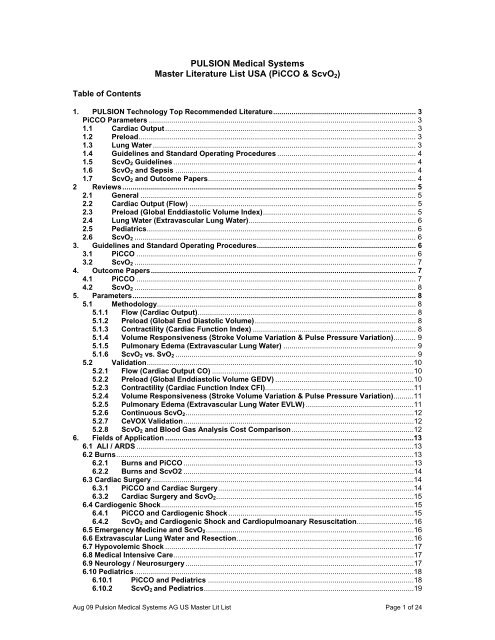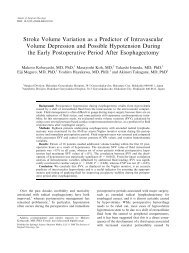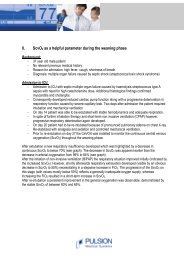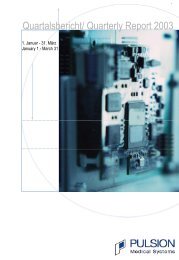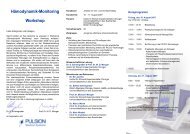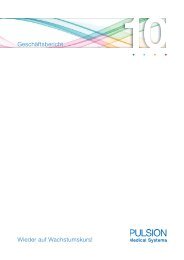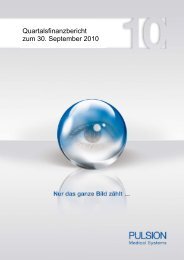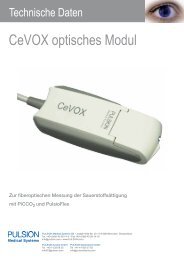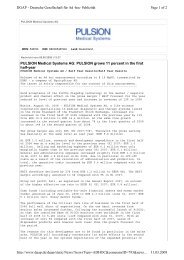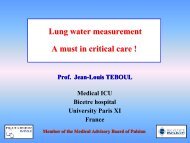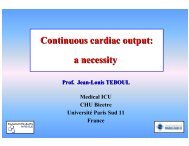PiCCO & ScvO2 - PULSION Medical Systems SE
PiCCO & ScvO2 - PULSION Medical Systems SE
PiCCO & ScvO2 - PULSION Medical Systems SE
Create successful ePaper yourself
Turn your PDF publications into a flip-book with our unique Google optimized e-Paper software.
Table of Contents<br />
<strong>PULSION</strong> <strong>Medical</strong> <strong>Systems</strong><br />
Master Literature List USA (<strong>PiCCO</strong> & <strong>ScvO2</strong>)<br />
1. <strong>PULSION</strong> Technology Top Recommended Literature...................................................................... 3<br />
<strong>PiCCO</strong> Parameters ................................................................................................................................... 3<br />
1.1 Cardiac Output........................................................................................................................... 3<br />
1.2 Preload........................................................................................................................................ 3<br />
1.3 Lung Water ................................................................................................................................. 3<br />
1.4 Guidelines and Standard Operating Procedures .................................................................... 4<br />
1.5 <strong>ScvO2</strong> Guidelines ....................................................................................................................... 4<br />
1.6 <strong>ScvO2</strong> and Sepsis ...................................................................................................................... 4<br />
1.7 <strong>ScvO2</strong> and Outcome Papers...................................................................................................... 4<br />
2 Reviews................................................................................................................................................ 5<br />
2.1 General ....................................................................................................................................... 5<br />
2.2 Cardiac Output (Flow) ............................................................................................................... 5<br />
2.3 Preload (Global Enddiastolic Volume Index)........................................................................... 5<br />
2.4 Lung Water (Extravascular Lung Water).................................................................................. 6<br />
2.5 Pediatrics.................................................................................................................................... 6<br />
2.6 <strong>ScvO2</strong> .......................................................................................................................................... 6<br />
3. Guidelines and Standard Operating Procedures.............................................................................. 6<br />
3.1 <strong>PiCCO</strong> ......................................................................................................................................... 6<br />
3.2 <strong>ScvO2</strong> .......................................................................................................................................... 7<br />
4. Outcome Papers.................................................................................................................................. 7<br />
4.1 <strong>PiCCO</strong> ......................................................................................................................................... 7<br />
4.2 <strong>ScvO2</strong> .......................................................................................................................................... 8<br />
5. Parameters........................................................................................................................................... 8<br />
5.1 Methodology............................................................................................................................... 8<br />
5.1.1 Flow (Cardiac Output)........................................................................................................... 8<br />
5.1.2 Preload (Global End Diastolic Volume)............................................................................... 8<br />
5.1.3 Contractility (Cardiac Function Index) ................................................................................ 8<br />
5.1.4 Volume Responsiveness (Stroke Volume Variation & Pulse Pressure Variation)........... 9<br />
5.1.5 Pulmonary Edema (Extravascular Lung Water) ................................................................. 9<br />
5.1.6 <strong>ScvO2</strong> vs. SvO2 ...................................................................................................................... 9<br />
5.2 Validation...................................................................................................................................10<br />
5.2.1 Flow (Cardiac Output CO) ...................................................................................................10<br />
5.2.2 Preload (Global Enddiastolic Volume GEDV) ....................................................................10<br />
5.2.3 Contractility (Cardiac Function Index CFI).........................................................................11<br />
5.2.4 Volume Responsiveness (Stroke Volume Variation & Pulse Pressure Variation)..........11<br />
5.2.5 Pulmonary Edema (Extravascular Lung Water EVLW) .....................................................11<br />
5.2.6 Continuous <strong>ScvO2</strong>................................................................................................................12<br />
5.2.7 CeVOX Validation.................................................................................................................12<br />
5.2.8 <strong>ScvO2</strong> and Blood Gas Analysis Cost Comparison............................................................12<br />
6. Fields of Application ..........................................................................................................................13<br />
6.1 ALI / ARDS ........................................................................................................................................13<br />
6.2 Burns..................................................................................................................................................13<br />
6.2.1 Burns and <strong>PiCCO</strong> .................................................................................................................13<br />
6.2.2 Burns and <strong>ScvO2</strong> .................................................................................................................14<br />
6.3 Cardiac Surgery ................................................................................................................................14<br />
6.3.1 <strong>PiCCO</strong> and Cardiac Surgery................................................................................................14<br />
6.3.2 Cardiac Surgery and <strong>ScvO2</strong>.................................................................................................15<br />
6.4 Cardiogenic Shock............................................................................................................................15<br />
6.4.1 <strong>PiCCO</strong> and Cardiogenic Shock ...........................................................................................15<br />
6.4.2 <strong>ScvO2</strong> and Cardiogenic Shock and Cardiopulmoanary Resuscitation............................16<br />
6.5 Emergency Medicine and <strong>ScvO2</strong>......................................................................................................16<br />
6.6 Extravascular Lung Water and Resection.......................................................................................16<br />
6.7 Hypovolemic Shock ..........................................................................................................................17<br />
6.8 <strong>Medical</strong> Intensive Care......................................................................................................................17<br />
6.9 Neurology / Neurosurgery ................................................................................................................17<br />
6.10 Pediatrics .........................................................................................................................................18<br />
6.10.1 <strong>PiCCO</strong> and Pediatrics .....................................................................................................18<br />
6.10.2 <strong>ScvO2</strong> and Pediatrics.......................................................................................................19<br />
Aug 09 Pulsion <strong>Medical</strong> <strong>Systems</strong> AG US Master Lit List Page 1 of 24
6.11 Pulmonary Edema...........................................................................................................................20<br />
6.12 <strong>ScvO2</strong> as an Indicator for Blood Transfusion ...............................................................................20<br />
6.13 Septic Shock....................................................................................................................................20<br />
6.13.1 <strong>PiCCO</strong> and Septic Shock ................................................................................................20<br />
6.13.2 <strong>ScvO2</strong> and Septic Shock .................................................................................................20<br />
6.14 Surgical Intensive Care...................................................................................................................21<br />
6.14.1 <strong>PiCCO</strong> and Surgical Intensive Care ...............................................................................21<br />
6.14.2 <strong>ScvO2</strong> and Surgical Intensive Care................................................................................21<br />
6.15 Transplantation ...............................................................................................................................22<br />
6.16 Trauma .............................................................................................................................................22<br />
7. <strong>PiCCO</strong> parameters in various clinical situations.............................................................................22<br />
8. Catheters.............................................................................................................................................23<br />
Aug 09 Pulsion <strong>Medical</strong> <strong>Systems</strong> AG US Master Lit List Page 2 of 24
1. <strong>PULSION</strong> Technology Top Recommended Literature<br />
<strong>PiCCO</strong> Parameters<br />
1.1 Cardiac Output<br />
Piehl MD, Manning JE, McCurdy SL, Rhue TS, Kocis KC, Cairns CB.<br />
Pulse contour cardiac output analysis in a piglet model of severe hemorrhagic shock<br />
Crit Care Med 2008; 36: 1189-95<br />
With Editorial<br />
Hanna BD. Childrens Hospital of Philadelphia.<br />
Where do we go from here? Cardiac output determination in pediatrics.<br />
Crit Care med 2008; 36: 1377-8<br />
Felbinger TW, Reuter DA, Eltzschig HK, Bayerlein J, Goetz AE.<br />
Cardiac index measurements during rapid preload changes: a comparison of pulmonary artery<br />
thermodilution with arterial pulse contour analysis<br />
J Clin Anesth 2005; 17(4):241-8<br />
1.2 Preload<br />
Benington S, Ferris P, Nirmalan M.<br />
Emerging trends in minimally invasive haemodynamic monitoring and optimization of fluid therapy<br />
Eur J Anaesthesiol 2009; epub<br />
Hofer CK, Furrer L, Matter-Ensner S, Maloigne M, Klaghofer R, Genoni M, Zollinger A.<br />
Volumetric preload measurement by thermodilution: a comparison with transoesophageal<br />
echocardiography<br />
Br J Anaesth 2005; 94(6):748-55<br />
Michard F, Alaya S, Zarka V, Bahloul M, Richard C, Teboul JL.<br />
Global end-diastolic volume as an indicator of cardiac preload in patients with septic shock<br />
Chest 2003; 124(5):1900-8<br />
1.3 Lung Water<br />
Berkowitz DM, Danai PA, Eaton S, Moss M, Martin G.<br />
Accurate characterization of extravascular lung water in acute respiratory distress syndrome<br />
Crit Care Med 2008; 36: 1803-9<br />
Phillips C, Chesnutt M, Smith M.<br />
Extravascular lung water in sepsis-associated acute respiratory distress syndrome: indexing with<br />
predicted body weight improves correlation with severity of illness and survival<br />
Crit Care Med 2008; 36: 69-73<br />
Isakow W, Schuster DP.<br />
Extravascular lung water measurements and hemodynamic monitoring in the critically ill: bedside<br />
alternatives to the pulmonary artery catheter<br />
Am J Physiol Lung Cell Mol Physiol 2006; 291: 1118 - 33<br />
Martin GS, Eaton S, Mealer M, Moss M.<br />
Extravascular lung water in patients with severe sepsis: a prospective cohort study<br />
Crit Care 2005; 9: R74-82<br />
Mitchell JP, Schuller D, Calandrino FS, Schuster DP.<br />
Improved outcome based on fluid management in critically ill patients requiring pulmonary artery<br />
catheterization<br />
Am Rev Respir Dis 1992; 145: 990-8<br />
Aug 09 Pulsion <strong>Medical</strong> <strong>Systems</strong> AG US Master Lit List Page 3 of 24
1.4 Guidelines and Standard Operating Procedures<br />
Brierley J, Choong K, Cornell T, Decaen A,Deymann A, Doctor A, Davis A, Duff J, Dugas MA et al.<br />
2007 American College of Critical Care Medicine clinical practice parameters for hemodynamic<br />
support of pediatric and neonatal septic shock<br />
Crit Care Med 2009; 37(2): 666 – 688<br />
Dellinger RP, Levy MM, Carlet JM, Bion J, Parker MM, Jaeschke R, Reinhart K, Angus DC, Brun-Buisson C,<br />
Beale R, Calandra T, Dhainaut JF, Gerlach H, Harvey M, Marini JJ, Marshall J, Ranieri M, Ramsay G,<br />
Sevransky J, Thompson BT, Townsend S, Vender JS, Zimmerman JL, Vincent JL.<br />
Surviving Sepsis Campaign: International guidelines for management of severe sepsis and septic<br />
shock: 2008<br />
Intensive Care Med 2008; 34: 17-60<br />
Goepfert M, Reuter D, Akyol D, Lamm P, Kilger E, Goetz A.<br />
Goal directed fluid management reduces vasopressor and catecholamine use in cardiac surgery<br />
patients<br />
Intensive Care Medicine 2007; 33: 96-103<br />
1.5 <strong>ScvO2</strong> Guidelines<br />
Dellinger RP, Levy MM, Carlet JM, Bion J, Parker MM, Jaeschke R, Reinhart K, Angus DC, Brun-Buisson C,<br />
Beale R, Calandra T, Dhainaut JF, Gerlach H, Harvey M, Marini JJ, Marshall J, Ranieri M, Ramsay G,<br />
Sevransky J, Thompson BT, Townsend S, Vender JS, Zimmerman JL, Vincent JL.<br />
Surviving Sepsis Campaign: International guidelines for management of severe sepsis and septic<br />
shock: 2008<br />
Intensive Care Med 2008; 34(1): 17-60<br />
1.6 <strong>ScvO2</strong> and Sepsis<br />
Rivers ER, Nguyen B, Havstad S, Ressler J, Muzzin A, Knoblich B, Peterson E, Tomlanovich M.<br />
Early goal-directed therapy in the treatment of severe sepsis and septic shock<br />
N Eng J Med 2001; 345:1368–7<br />
Trzeciak S, Dellinger RP, Abate NL, Cowan RM, Stauss M, Kilgannon JH, Zanotti S, Parrillo JE.<br />
Translating research to clinical practice: a 1-year experience with implementing early goal-directed<br />
therapy for septic shock in the emergency department<br />
Chest 2006; 129:225-32<br />
1.7 <strong>ScvO2</strong> and Outcome Papers<br />
Smetkin AA, Kirov M, Kuzkov VV, Lenkin AI, Eremeev AV, Slastilin VY, Borodin VV, Bjertnaes LJ.<br />
Single transpulmonary thermodilution and continuous monitoring of central venous oxygen<br />
saturation during off-pump coronary surgery.<br />
Acta Anaesthesiol Scand 2009; 53: 505-14<br />
Csontos C, Foldi V, Fischer T, Bogar L.<br />
Arterial thermodilution in burn patients suggests a more rapid fluid administration during early<br />
resuscitation.<br />
Acta Anaesthesiol Scand 2008; 52(6): 742-9<br />
Aug 09 Pulsion <strong>Medical</strong> <strong>Systems</strong> AG US Master Lit List Page 4 of 24
2 Reviews<br />
2.1 General<br />
King D & Price AM<br />
Measuring cardiac output using the <strong>PiCCO</strong> system<br />
British Journal of Cardiac Nursing 2008; 3 (11): 512-519<br />
Malbrain M, De Potter P, Deeren D.<br />
Cost Effectiveness of minimally invasive hemodynamic monitoring<br />
In: Vincent JL (Ed.), Yearbook of Intensive Care and Emergency Medicine 2005: 603-18<br />
Genahr A, McLuckie A.<br />
Transpulmonary thermodilution in the critically ill<br />
Brit J Int Care 2004: 6-10<br />
Michard F, Perel A.<br />
Management of circulatory and respiratory failure using less invasive hemodynamic monitoring<br />
In: Vincent JL (Ed.), Yearbook of Intensive Care and Emergency Medicine 2003: 508-20<br />
Cottis R, Magee N, Higgins DJ.<br />
Haemodynamic monitoring with pulse-induced contour cardiac output (<strong>PiCCO</strong>) in critical care<br />
Intensive Crit Care Nurs 2003; 19: 301-7<br />
Bellomo R, Uchino S.<br />
Cardiovascular monitoring tools: use and misuse<br />
Curr Opin Crit Care 2003; 9(3): 225-9<br />
Salukhe TV, Wyncoll DL<br />
Volumetric haemodynamic monitoring and continuous pulse contour analysis – an untapped<br />
resource for coronary and high dependency care units<br />
Br J Cardiol 2002; 9(1): AIC 20 – 25<br />
2.2 Cardiac Output (Flow)<br />
Smith JA, Camporota L, Beale R<br />
Monitoring arterial blood pressure and cardiac output using central or peripheral arterial pressure<br />
waveforms<br />
Yearbook of Intensive and Emergency Medicine 2009; 285 – 296<br />
Della Rocca G, Costa MG.<br />
Volumetric monitoring: principles of application<br />
Minerva Anestesiol 2005; 71:303-6<br />
2.3 Preload (Global Enddiastolic Volume Index)<br />
Benington S, Ferris P, Nirmalan M.<br />
Emerging trends in minimally invasive haemodynamic monitoring and optimization of fluid therapy<br />
Eur J Anaesthesiol 2009; epub<br />
Della Rocca G, Costa MG.<br />
Intrathoracic Blood Volume: Clinical Applications<br />
In: Vincent JL (Ed.), Yearbook of Intensive Care and Emergency Medicine 2006: 143-52<br />
Michard F.<br />
Do we need to know cardiac preload?<br />
In: Vincent JL (Ed.), Yearbook of Intensive Care and Emergency Medicine 2004: 694-701<br />
Aug 09 Pulsion <strong>Medical</strong> <strong>Systems</strong> AG US Master Lit List Page 5 of 24
2.4 Lung Water (Extravascular Lung Water)<br />
Khan S, Trof RJ, Groeneveld ABJ.<br />
Transpulmonary dilution-derived extravascular lung water as a measure of lung edema<br />
Curr Opin Crit Care 2007; 13 (3):303-7<br />
Fernandez-Mondejar E, Guerrero-López F, Colmenero M.<br />
How important is the measurement of extravascular lung water?<br />
Curr Opin Crit Care 2007; 13: 79-83<br />
Michard F.<br />
Bedside assessment of extravascular lung water by dilution methods: temptations and pitfalls<br />
Crit Care Med 2007; 35(4):1186-92<br />
Isakow W, Schuster DP.<br />
Extravascular lung water measurements and hemodynamic monitoring in the critically ill: bedside<br />
alternatives to the pulmonary artery catheter<br />
Am J Physiol Lung Cell Mol Physiol 2006; 291: 1118-33<br />
Kirov MY, Kuzkov VV, Bjertnaes LJ.<br />
Extravascular lung water in sepsis<br />
In: Vincent JL (Ed.), Yearbook of Intensive Care and Emergency Medicine 2005: 449-60<br />
Groeneveld ABJ.<br />
Value and limitations of measuring extravascular lung water<br />
Int J Intensive Care 2007; Autumn: 84-6<br />
2.5 Pediatrics<br />
Tibby SM, Murdoch IA.<br />
Measurement of cardiac output and tissue perfusion<br />
Curr Opin Pediatr 2002; 14(3):303-9<br />
2.6 <strong>ScvO2</strong><br />
Bauer P, Reinhart K, Bauer M.<br />
Early goal directed therapy and outcome in septic shock<br />
Int J Intensive Care 2007; Autumn:19-24<br />
Marx G, Reinhart K.<br />
Venous oximetry<br />
Curr Opin Crit Care 2006; 12:263-8<br />
Goodrich C.<br />
Continuous central venous oximetry monitoring<br />
Crit Care Nurs Clin North Am 2006; 18:203-9<br />
Rivers EP, Ander DS, Powell D.<br />
Central venous oxygen saturation monitoring in the critically ill patient<br />
Curr Opin Crit Care 2001; 7:204-11<br />
3. Guidelines and Standard Operating Procedures<br />
3.1 <strong>PiCCO</strong><br />
Brierley J, Choong K, Cornell T, Decaen A,Deymann A, Doctor A, Davis A, Duff J, Dugas MA et al.<br />
2007 American College of Critical Care Medicine clinical practice parameters for hemodynamic<br />
support of pediatric and neonatal septic shock<br />
Crit Care Med 2009; 37(2): 666 – 688<br />
Aug 09 Pulsion <strong>Medical</strong> <strong>Systems</strong> AG US Master Lit List Page 6 of 24
Dellinger RP, Levy MM, Carlet JM, Bion J, Parker MM, Jaeschke R, Reinhart K, Angus DC, Brun-Buisson C,<br />
Beale R, Calandra T, Dhainaut JF, Gerlach H, Harvey M, Marini JJ, Marshall J, Ranieri M, Ramsay G,<br />
Sevransky J, Thompson BT, Townsend S, Vender JS, Zimmerman JL, Vincent JL.<br />
Surviving Sepsis Campaign: International guidelines for management of severe sepsis and septic<br />
shock: 2008<br />
Intensive Care Med 2008; 34(1): 17-60<br />
Kortgen A, Niederprün P, Bauer M.<br />
Implementation of an evidence-based „standard operating procedure“ and outcome in septic shock<br />
Crit Care Med 2006; 34(4):939-9<br />
3.2 <strong>ScvO2</strong><br />
Smetkin AA, Kirov M, Kuzkov VV, Lenkin AI, Eremeev AV, Slastilin VY, Borodin VV, Bjertnaes LJ.<br />
Single transpulmonary thermodilution and continuous monitoring of central venous oxygen<br />
saturation during off-pump coronary surgery.<br />
Acta Anaesthesiol Scand 2009; 53: 505-14<br />
Dellinger RP, Levy MM, Carlet JM, Bion J, Parker MM, Jaeschke R, Reinhart K, Angus DC, Brun-Buisson C,<br />
Beale R, Calandra T, Dhainaut JF, Gerlach H, Harvey M, Marini JJ, Marshall J, Ranieri M, Ramsay G,<br />
Sevransky J, Thompson BT, Townsend S, Vender JS, Zimmerman JL, Vincent JL.<br />
Surviving Sepsis Campaign: International guidelines for management of severe sepsis and septic<br />
shock: 2008<br />
Intensive Care Med 2008; 34(1): 17-60<br />
De Oliveira CF, de Oliveira DS, Gottschald AF, Moura JD, Costa GA, Ventura AC, Fernandes JC, Vaz FA,<br />
Carcillo JA, Rivers EP, Troster EJ.<br />
ACCM / PALS haemodynamic support guidelines for paediatric septic shock: an outcomes<br />
comparison with and without monitoring central venous oxygen saturation<br />
ICM 2008; 34 (6): 1065-75<br />
Kortgen A, Niederprün P, Bauer M.<br />
Implementation of an evidence-based „standard operating procedure“ and outcome in septic shock<br />
Crit Care Med 2006; 34(4):939-9<br />
Trzeciak S, Dellinger RP, Abate NL, Cowan RM, Stauss M, Kilgannon JH, Zanotti S, Parrillo JE.<br />
Translating research to clinical practice: a 1-year experience with implementing early goal-directed<br />
therapy for septic shock in the emergency department<br />
Chest 2006; 129:225-32<br />
4. Outcome Papers<br />
4.1 <strong>PiCCO</strong><br />
Smetkin AA, Kirov M, Kuzkov VV, Lenkin AI, Eremeev AV, Slastilin VY, Borodin VV, Bjertnaes LJ.<br />
Single transpulmonary thermodilution and continuous monitoring of central venous oxygen<br />
saturation during off-pump coronary surgery.<br />
Acta Anaesthesiol Scand 2009; 53: 505-14<br />
Goepfert M, Reuter D, Akyol D, Lamm P, Kilger E, Goetz A.<br />
Goal directed fluid management reduces vasopressor and catecholamine use in cardiac surgery<br />
patients<br />
Intensive Care Medicine 2007; 33: 96-103<br />
Csontos C, Foldi V, Fischer T, Bogar L.<br />
Arterial thermodilution in burn patients suggests a more rapid fluid administration during early<br />
resuscitation.<br />
Acta Anaesthesiol Scand 2008; 52(6): 742-9<br />
Mitchell JP, Schuller D, Calandrino FS, Schuster DP.<br />
Improved outcome based on fluid management in critically ill patients requiring pulmonary artery<br />
catheterization<br />
Am Rev Respir Dis 1992; 145(5): 990-8<br />
Aug 09 Pulsion <strong>Medical</strong> <strong>Systems</strong> AG US Master Lit List Page 7 of 24
4.2 <strong>ScvO2</strong><br />
Smetkin AA, Kirov M, Kuzkov VV, Lenkin AI, Eremeev AV, Slastilin VY, Borodin VV, Bjertnaes LJ.<br />
Single transpulmonary thermodilution and ocntinuous monitoring of central venous oxygen<br />
saturation during off-pump coronary surgery.<br />
Acta Anaesthesiol Scand 2009; 53:505-14<br />
Csontos C, Foldi V, Fischer T, Bogar L.<br />
Arterial thermodilution in burn patients suggests a more rapid fluid administration during early<br />
resuscitation.<br />
Acta Anaesthesiol Scand 2008; 52(6): 742-9<br />
5. Parameters<br />
5.1 Methodology<br />
5.1.1 Flow (Cardiac Output)<br />
Faybik P, Hetz H, Baker A, Yankovskaya E, Krenn CG, Steltzer H.<br />
Iced versus room temperature injectate for assessment of cardiac output, intrathoracic blood<br />
volume, and extravascular lung water by single transpulmonary thermodilution<br />
J Crit Care 2004; 19(2):103-7<br />
Segal E, Katzenelson R, Berkenstadt H, Perel A.<br />
Transpulmonary thermodilution cardiac output measurement using the axillary artery in critically ill<br />
patients<br />
J Clin Anesth 2002; 14(3):210-3<br />
Sakka SG, Meier-Hellmann A.<br />
Evaluation of cardiac output and cardiac preload<br />
In: Vincent JL (Ed.), Yearbook of Intensive Care and Emergency Medicine 2000: 671-9<br />
5.1.2 Preload (Global End Diastolic Volume)<br />
Hofer CK, Furrer L, Matter-Ensner S, Maloigne M, Klaghofer R, Genoni M, Zollinger A.<br />
Volumetric preload measurement by thermodilution: a comparison with transoesophageal<br />
echocardiography<br />
Br J Anaesth 2005; 94(6):748-55<br />
Buhre W, Buhre K, Kazmaier S, Sonntag H, Weyland A.<br />
Assessment of cardiac preload by indicator dilution and transoesophageal echocardiography<br />
Eur J Anaesthesiol 2001; 18(10):662-7<br />
McLuckie A, Bihari D.<br />
Investigating the relationship between intrathoracic blood volume index and cardiac index<br />
Intensive Care Med 2000; 26(9):1376-8<br />
5.1.3 Contractility (Cardiac Function Index)<br />
Michard F, Perel A.<br />
Management of circulatory and respiratory failure using less invasive hemodynamic monitoring<br />
In: Vincent JL (Ed.), Yearbook of Intensive Care and Emergency Medicine 2003: 508-20<br />
Wisner-Euteneier AJ, Lichtwarck-Aschoff M, Zimmermann G, Bluemel G, Pfeiffer U.<br />
Evaluation of the cardiac function index as a new bedside indicator of cardiac performance<br />
Intensive Care Med 1994; 20(S2):21<br />
Aug 09 Pulsion <strong>Medical</strong> <strong>Systems</strong> AG US Master Lit List Page 8 of 24
5.1.4 Volume Responsiveness (Stroke Volume Variation & Pulse Pressure Variation)<br />
Reuter DA, Goepfert MS, Goresch T, Schmoeckel M, Kilger E, Goetz AE.<br />
Assessing fluid responsiveness during open chest conditions<br />
Br J Anaesth 2005; 94(3):318-23<br />
Rex S, Brose S, Metzelder S, Huneke R, Schalte G, Autschbach R, Rossaint R, Buhre W.<br />
Prediction of fluid responsiveness in patients during cardiac surgery<br />
Br J Anaesth 2004; 93 (6):782-8<br />
Reuter DA, Felbinger TW, Kilger E, Schmidt C, Lamm P,Goetz AE.<br />
Optimizing fluid therapy in mechanically ventilated patients after cardiac surgery by on-line<br />
monitoring of left ventricular stroke volume variations. Comparison with aortic systolic pressure<br />
variations<br />
Br J Anaesth 2002; 88(1):124-6<br />
5.1.5 Pulmonary Edema (Extravascular Lung Water)<br />
Berkowitz DM, Danai PA, Eaton S, Moss M, Martin G.<br />
Accurate characterization of extravascular lung water in acute respiratory distress syndrome<br />
Crit Care Med 2008; 36(6): 1803-9<br />
Phillips C, Chesnutt M, Smith M.<br />
Extravascular lung water in sepsis-associated acute respiratory distress syndrome: indexing with<br />
predicted body weight improves correlation with severity of illness and survival<br />
Crit Care Med 2008; 36(1): 69-73<br />
Isakow W, Schuster DP.<br />
Extravascular lung water measurements and hemodynamic monitoring in the critically ill: bedside<br />
alternatives to the pulmonary artery catheter<br />
Am J Physiol Lung Cell Mol Physiol 2006: 291(6):1118-33<br />
Kuzkov V, Kirov M, Sovershaev M, Kulkin V, Suberov E, Waerhaug K, Bjertnaes L.<br />
Extravascular lung water determined with single transpulmonary thermodilution correlates with the<br />
severity of sepsis-induced acute lung injury<br />
Crit Care Med 2006; 34(6):1647-53<br />
Kirov MY, Kuzkov VV, Bjertnaes LJ.<br />
Extravascular lung water in sepsis<br />
In: Vincent JL (Ed.), Yearbook of Intensive Care and Emergency Medicine 2005: 449-60<br />
Sakka SG, Klein M, Reinhart K, Meier-Hellmann A.<br />
Prognostic value of extravascular lung water in critically ill patients<br />
Chest 2002; 122(6):2080-6<br />
5.1.6 <strong>ScvO2</strong> vs. SvO2<br />
el-Masry A, Mukhtar MA, el-Sherbeny AM, Fathy M, el-Meteini M<br />
Comparison of central venous oxygen saturation and mixed venous oxygen saturation during liver<br />
transplantation<br />
Anaesthesia 2009; 64(4): 378-82<br />
Kopterides P, Bonovas S, Mavrou I, Kostadima E, Zakynthinos E, Armaganidis AS.<br />
Venous Oxygen Saturation and Lactate Gradient from Superior Vena Cava to Pulmonary Artery in<br />
Patients with Septic Shock<br />
Shock 2008; 31(6): 561-7<br />
Sander M, Spies CD, Foer A, Weymann L, Braun J, Volk T, Grubitzsch H, von Heymann C.<br />
Agreement of central venous saturation and mixed venous saturation in cardiac surgery patients<br />
Intensive Care Med 2007; 33(10): 1719-25<br />
Aug 09 Pulsion <strong>Medical</strong> <strong>Systems</strong> AG US Master Lit List Page 9 of 24
Dueck MH, Klimek M, Appenrodt S, Weigand C, Boerner U.<br />
Trends but not individual values of central venous oxygen saturation agree with mixed venous<br />
oxygen saturation during varying hemodynamic conditions<br />
Anesthesiology 2005; 103:249-57<br />
Reinhart K, Kuhn HJ, Hartog C, Bredle DL.<br />
Continuous central venous and pulmonary artery oxygen saturation monitoring in the critically ill<br />
Curr Opin Crit Care 2004; 30:1572-8<br />
Ladakis C, Myrianthefs P, Karabinis A, Karatzas G, Dosios T, Fildissis G, Gogas J, Baltopoulos G.<br />
Central venous and mixed venous oxygen saturation in critically ill patients<br />
Respiration 2001; 68:279-85<br />
5.2 Validation<br />
5.2.1 Flow (Cardiac Output CO)<br />
Felbinger TW, Reuter DA, Eltzschig HK, Bayerlein J, Goetz AE.<br />
Cardiac index measurements during rapid preload changes: a comparison of pulmonary artery<br />
thermodilution with arterial pulse contour analysis<br />
J Clin Anesth 2005; 17(4):241-8<br />
Marx G, Schuerholz T, Sumpelmann R, Simon T, Leuwer M.<br />
Comparison of cardiac output measurements by arterial trans-cardiopulmonary and pulmonary<br />
arterial thermodilution with direct Fick in septic shock<br />
Eur J Anaesthesiol 2005; 22(2):129-34<br />
Bein B, Worthmann F, Tonner PH, Paris A, Steinfath M, Hedderich J, Scholz J.<br />
Comparison of esophageal Doppler, pulse contour analysis, and real-time pulmonary artery<br />
thermodilution for the continuous measurement of cardiac output<br />
J Cardiothorac Vasc Anesth 2004; 18(2):185-9<br />
Godje O, Hoke K, Goetz AE, Felbinger TW, Reuter DA, Reichart B, Friedl R, Hannekum A, Pfeiffer UJ.<br />
Reliability of a new algorithm for continuous cardiac output determination by pulse-contour analysis<br />
during hemodynamic instability<br />
Crit Care Med 2002; 30(1):52-8<br />
Sakka SG, Reinhart K, Wegscheider K, Meier-Hellmann A.<br />
Is the placement of a pulmonary artery catheter still justified solely for the measurement of cardiac<br />
output?<br />
J Cardiothorac Vasc Anesth 2000; 14(2):119-24<br />
5.2.2 Preload (Global Enddiastolic Volume GEDV)<br />
Renner J, Gruenewald M, Brand P, Steinfath M, Scholz J, Lutter G, Bein B.<br />
Global End-Diastolic Volume as a Variable of Fluid Responsiveness During Acute Changing Loading<br />
Conditions<br />
J Cardiothorac Vasc Anesth 2007; 21(5): 650-4<br />
Kozieras, J, Thuemer O, Sakka SG.<br />
Influence of an acute increase in systemic vascular resistance on transpulmonary thermodilutionderived<br />
parameters in critically ill patients<br />
Intensive Care Med 2007; 33:1619-23<br />
Michard F, Alaya S, Zarka V, Bahloul M, Richard C, Teboul JL.<br />
Global end-diastolic volume as an indicator of cardiac preload in patients with septic shock<br />
Chest 2003; 124(5):1900-8<br />
Reuter DA, Felbinger TW, Moerstedt K, Weis F, Schmidt C, Kilger E, Goetz AE.<br />
Intrathoracic blood volume index measured by thermodilution for preload monitoring after cardiac<br />
surgery<br />
J Cardiothorac Vasc Anesth 2002; 16(2):191-5<br />
Aug 09 Pulsion <strong>Medical</strong> <strong>Systems</strong> AG US Master Lit List Page 10 of 24
5.2.3 Contractility (Cardiac Function Index CFI)<br />
Ritter S, Rudiger A, Maggiorini M<br />
Transpulmonary thermodilution derived cardiac function index identifies cardiac dysfunction in<br />
acute heart failure and septic patients: an observational study<br />
Crit Care 2009; 13(4): R133<br />
Combes A, Berneau JB, Luyt CE, Trouillet JL.<br />
Estimation of left ventricular systolic function by single transpulmonary thermodilution<br />
Intensive Care Med 2004; 30(7):1377-83<br />
5.2.4 Volume Responsiveness (Stroke Volume Variation & Pulse Pressure Variation)<br />
Kubitz JC, Annecke T, Forkl S, Kemming GI, Kronas N, Goetz AE, Reuter DA.<br />
Validation of pulse contour derived stroke volume variation during modifications of cardiac afterload<br />
Br J Anaesth 2007; 98(5): 591-7<br />
Hofer CK, Muller SM, Furrer L, Klaghofer R, Genoni M, Zollinger A.<br />
Stroke volume and pulse pressure variation for prediction of fluid responsiveness in patients<br />
undergoing off-pump coronary artery bypass grafting<br />
Chest 2005; 128(2):848-54<br />
Reuter DA, Kirchner A, Felbinger TW, Weis FC, Kilger E, Lamm P, Goetz AE.<br />
Usefulness of left ventricular stroke volume variation to assess fluid responsiveness in patients with<br />
reduced cardiac function<br />
Crit Care Med 2003; 31(5):1399-404<br />
Michard F, Boussat S, Chemla D, Anguel N, Mercat A, Lecarpentier Y, Richard C, Pinsky MR, Teboul JL.<br />
Relation between respiratory changes in arterial pulse pressure and fluid responsiveness in septic<br />
patients with acute circulatory failure<br />
Am J Respir Crit Care Med 2000; 162(1):134-8<br />
5.2.5 Pulmonary Edema (Extravascular Lung Water EVLW)<br />
Mutoh T, Kazumata K, Ishikawa T, Terasaka S<br />
Performance of Bedside Transpulmonary Thermodilution Monitoring for Goal-Directed<br />
Hemodynamic Management After Subarachnoid Hemorrhage<br />
Stroke 2009; 40(7): 2368 - 74<br />
Monnet X, Anguel N, Osman D, Hamzaoui, Richard C, Teboul JL.<br />
Assessing pulmonary permeability by transpulmonary thermodilution allows differentiation of<br />
hydrostatic pulmonary edema from ALI / ARDS<br />
Intensive Care Medicine 2007; 33(3):448-53<br />
Kuzkov VV, Suborov EV, Kirov MY, Kuklin VN, Sobhkhez M, Johnsen S, Waerhaug K, Bjertnaes LJ.<br />
Extravascular lung water after pneumonectomy and one-lung ventilation in sheep<br />
Crit Care Med 2007; 35 (6):1550-9<br />
Michard F, Schachtrupp A, Toens C.<br />
Factors influencing the estimation of extravascular lung water by transpulmonary thermodilution in<br />
critically ill patients<br />
Crit Care Med 2005; 33(6):1243-7<br />
Kirov MY, Kuzkov VV, Kuklin VN, Waerhaug K, Bjertnaes LJ.<br />
Extravascular lung water assessed by transpulmonary single thermodilution and postmortem<br />
gravimetry in sheep<br />
Crit Care 2004; 8(6):R451-8<br />
Katzenelson R, Perel A, Berkenstadt H, Preisman S, Kogan S, Sternik L, Segal E.<br />
Accuracy of transpulmonary thermodilution versus gravimetric measurement of extravascular lung<br />
water<br />
Crit Care Med 2004; 32(7):1550-4<br />
Aug 09 Pulsion <strong>Medical</strong> <strong>Systems</strong> AG US Master Lit List Page 11 of 24
Sakka SG, Ruhl CC, Pfeiffer UJ, Beale R, McLuckie A, Reinhart K, Meier-Hellmann A.<br />
Assessment of cardiac preload and extravascular lung water by single transpulmonary<br />
thermodilution<br />
Intensive Care Medicine 2000; 26 (2):180-7<br />
5.2.6 Continuous <strong>ScvO2</strong><br />
Rivers ER, Nguyen B, Havstad S, Ressler J, Muzzin A, Knoblich B, Peterson E, Tomlanovich M.<br />
Early goal-directed therapy in the treatment of severe sepsis and septic shock<br />
N Eng J Med 2001; 345:1368–7<br />
Hofer CK, Ganter M, Fodor P, Tavakoli R, Genoni M, Zollinger A.<br />
Continuous central venous oxygenation measurement by CeVOX in patients undergoing off-pump<br />
coronary bypass grafting<br />
Crit Care 2006:P340<br />
Rady MY, Rivers EP, Martin GB, Smithline H, Appelton T, Nowak RM.<br />
Continuous central venous oximetry and shock index in the emergency department: use in the<br />
evaluation of clinical shock<br />
Am J Emerg Med 1992; 10:538-41<br />
5.2.7 CeVOX Validation<br />
Molnar Z, Umgelter A, Toth I, Livingstone D, Weyland A, Sakka SG, Meier-Hellmann A.<br />
Continuous monitoring of ScvO(2) by a new fibre-optic technology compared with blood gas<br />
oximetry in critically ill patients: a multicentre study<br />
Intensive Care Med 2007; 33(10): 1767-70<br />
Muller M, Lohr T, Scholz S, Thul J, Akinturk H, Hempelmann G.<br />
Continuous SvO(2) measurement in infants undergoing congenital heart surgery - first clinical<br />
experiences with a new fiberoptic probe<br />
Paediatr Anaesth. 2007; 17(1):51-5.<br />
Huber D, Osthaus W, Optenhöfel J, Breymann T, Marx G, Piepenbrock S, Sümpelmann R.<br />
Continuous monitoring of central venous oxygen saturation in neonates and small infants: in vitro<br />
evaluation of two different oximetry catheters<br />
Paediatr Anaesth 2006; 16(12):1257-61<br />
Ducart A, Dejonckheere M, Koch M, Perrin L, Schmartz D.<br />
Continuous central venous and pulmonary artery oxygen saturation monitoring in cardiac surgery<br />
after cardiopulmonary bypass<br />
Eur J Anaesthesiol 2007; 4AP2-7<br />
Hofer CK, Ganter M, Fodor P, Tavakoli R, Genoni M, Zollinger A.<br />
Continuous central venous oxygenation measurement by CeVOX in patients undergoing off-pump<br />
coronary bypass grafting<br />
Crit Care 2006:P340<br />
5.2.8 <strong>ScvO2</strong> and Blood Gas Analysis Cost Comparison<br />
Bloos F, Rissner F, Specht M, Reinhart K, Marx G<br />
Costs of intermittent measurement of central venous oxygen saturations by blood gas analysis<br />
Intensive Care Med 2009; 35(7): 1316-7<br />
Aug 09 Pulsion <strong>Medical</strong> <strong>Systems</strong> AG US Master Lit List Page 12 of 24
6. Fields of Application<br />
6.1 ALI / ARDS<br />
Berkowitz DM, Danai PA, Eaton S, Moss M, Martin GS.<br />
Alcohol Abuse Enhances Pulmonary Edema in Acute Respiratory Distress Syndrome<br />
Alcohol Clin Exp Res 2009; epub<br />
Berkowitz DM, Danai PA, Eaton S, Moss M, Martin G.<br />
Accurate characterization of extravascular lung water in acute respiratory distress syndrome<br />
Crit Care Med 2008; 36(6): 1803-9<br />
Phillips C, Chesnutt M, Smith M.<br />
Extravascular lung water in sepsis-associated acute respiratory distress syndrome: indexing with<br />
predicted body weight improves correlation with severity of illness and survival<br />
Crit Care Med, 2008: 36(1); 69-73<br />
Monnet X, Anguel N, Osman D, Hamzaoui, Richard C, Teboul JL.<br />
Assessing pulmonary permeability by transpulmonary thermodilution allows differentiation of<br />
hydrostatic pulmonary edema from ALI / ARDS<br />
Intensive Care Medicine 2007; 33(3): 448-53<br />
Kuzkov V, Kirov M, Sovershaev M, Kulkin V, Suberov E, Waerhaug K, Bjertnaes L.<br />
Extravascular lung water determined with single transpulmonary thermodilution correlates with the<br />
severity of sepsis-induced acute lung injury<br />
Crit Care Med 2006; 34(6):1647-53<br />
Perkins GD, McAuley DF, Thickett DR, Gao F.<br />
The beta-agonist lung injury trial (BALTI): a randomized placebo-controlled clinical trial<br />
Am J Respir Crit Care Med 2006; 173(3): 281-7<br />
Martin GS, Eaton S, Mealer M, Moss M.<br />
Extravascular lung water in patients with severe sepsis: a prospective cohort study<br />
Crit Care 2005; 9(2):R74-82<br />
Patroniti N, Bellani G, Maggioni E, Manfio A, Marcora B, Pesenti A.<br />
Measurement of pulmonary edema in patients with acute respiratory distress syndrome<br />
Crit Care Med 2005; 33(11):2547-54<br />
McAuley DF, Giles S, Fichter H, Perkins GD, Gao F.<br />
What is the optimal duration of ventilation in the prone position in acute lung injury and acute<br />
respiratory distress syndrome?<br />
Intensive Care Med 2002; 28(4):414-8<br />
6.2 Burns<br />
6.2.1 Burns and <strong>PiCCO</strong><br />
Csontos C, Foldi V, Fischer T, Bogar L.<br />
Arterial thermodilution in burn patients suggests a more rapid fluid administration during early<br />
resuscitation.<br />
Acta Anaesthesiol Scand 2008; 52(6): 742-9<br />
Koppl J, Karovic D, Podhoransky B, Csomor D, Gasparec P, Sagat T, Trimmel H.<br />
Hemodynamic monitoring using the <strong>PiCCO</strong> system in a 10 month old infant suffering from serious<br />
burn injury.<br />
Bratisl Lek Listy 2007 108(8): 359-363<br />
Holm C, Mayr M, Horbrand F, Tegeler J, Henckel von Donnersmarck G, Muhlbauer W, Pfeiffer UJ.<br />
Reproducibility of transpulmonary thermodilution measurements in patients with burn shock and<br />
hypothermia<br />
J Burn Care Rehabil 2005; 26(3):260-5<br />
Aug 09 Pulsion <strong>Medical</strong> <strong>Systems</strong> AG US Master Lit List Page 13 of 24
Holm C, Tegeler J, Mayr M, Pfeiffer U, Henckel von Donnersmarck G, Muhlbauer W.<br />
Effect of crystalloid resuscitation and inhalation injury on extravascular lung water: clinical<br />
implications<br />
Chest 2002; 121(6):1956-62<br />
Holm C, Melcer B, Horbrand F, Henckel von Donnersmarck G, Muhlbauer W.<br />
Arterial thermodilution: an alternative to pulmonary artery catheter for cardiac output assessment in<br />
burn patients<br />
Burns 2001; 27(2):161-6<br />
Holm C, Melcer B, Horbrand F, Worl H, von Donnersmarck GH, Muhlbauer W.<br />
Intrathoracic blood volume as an end point in resuscitation of the severely burned: an observational<br />
study of 24 patients<br />
J Trauma 2000; 48(4):728-34<br />
6.2.2 Burns and <strong>ScvO2</strong><br />
Csontos C, Foldi V, Fischer T, Bogar L.<br />
Arterial thermodilution in burn patients suggests a more rapid fluid administration during early<br />
resuscitation.<br />
Acta Anaesthesiol Scand 2008; 52(6): 742-9<br />
6.3 Cardiac Surgery<br />
6.3.1 <strong>PiCCO</strong> and Cardiac Surgery<br />
Smetkin AA, Kirov M, Kuzkov VV, Lenkin AI, Eremeev AV, Slastilin VY, Borodin VV, Bjertnaes LJ.<br />
Single transpulmonary thermodilution and continuous monitoring of central venous oxygen<br />
saturation during off-pump coronary surgery.<br />
Acta Anaesthesiol Scand 2009; 53: 505-14<br />
Goepfert M, Reuter D, Akyol D, Lamm P, Kilger E, Goetz A.<br />
Goal directed fluid management reduces vasopressor and catecholamine use in cardiac surgery<br />
patients<br />
Intensive Care Medicine 2007; 33: 96-103<br />
Kirov MY, Lenkin AI, Kuzkov V, Suburov EV, Slastilin VY, Borodin VV, Chernov II, Shonbin AN, Bjertnaes<br />
LJ.<br />
Single transpulmonary thermodilution in off-pump coronary artery bypass grafting: haemodynamic<br />
changes and effects of different anaesthetic techniques<br />
Acta Anesthesiol Scand 2007; 51: 426-33<br />
Wouters PF, Quaghebeur B, Sergeant P, Van Hemelrijck J, Vandermeersch E.<br />
Cardiac output monitoring using a brachial arterial catheter during off-pump coronary artery bypass<br />
grafting<br />
J Cardiothorac Vasc Anesth 2005; 19: 160-4<br />
Reuter DA, Goepfert MS, Goresch T, Schmoeckel M, Kilger E, Goetz AE.<br />
Assessing fluid responsiveness during open chest conditions<br />
Br J Anaesth 2005; 94(3):318-23<br />
Bettex DA, Hinselmann V, Hellermann JP, Jenni R, Schmid ER.<br />
Transoesophageal echocardiography is more unreliable for cardiac output assessment after cardiac<br />
surgery compared with thermodilution<br />
Anesthesia 2004; 59:1184-92<br />
Mielck F, Buhre W, Hanekop G, Tirilomis T, Hilgers R, Sonntag H.<br />
Comparison of continuous cardiac output measurements in patients after cardiac surgery<br />
J Cardiothorac Vasc Anesth 2003; 17(2):211-6<br />
Aug 09 Pulsion <strong>Medical</strong> <strong>Systems</strong> AG US Master Lit List Page 14 of 24
Brock H, Gabriel C, Bibl D, Necek S.<br />
Monitoring intravascular volumes for postoperative volume therapy<br />
Eur J Anaesthesiol 2002; 19(4):288-94<br />
Buhre W, Weyland A, Kazmaier S, Hanekop GG, Baryalei MM, Sydow M, Sonntag H.<br />
Comparison of cardiac output assessed by pulse-contour analysis and thermodilution in patients<br />
undergoing minimally invasive direct coronary artery bypass grafting<br />
J Cardiothorac Vasc Anesth 1999; 13(4):437-40<br />
Godje O, Hoke K, Lamm P, Schmitz C, Thiel C, Weinert M, Reichart B.<br />
Continuous, less invasive, hemodynamic monitoring in intensive care after cardiac surgery<br />
Thorac Cardiovasc Surg 1998; 46(4):242-9<br />
6.3.2 Cardiac Surgery and <strong>ScvO2</strong><br />
Smetkin AA, Kirov M, Kuzkov VV, Lenkin AI, Eremeev AV, Slastilin VY, Borodin VV, Bjertnaes LJ.<br />
Single transpulmonary thermodilution and ocntinuous monitoring of central venous oxygen<br />
saturation during off-pump coronary surgery.<br />
Acta Anaesthesiol Scand 2009; 53: 505-14<br />
Yazigi A, Abou-Zeid H, Madi-Jebara S, Haddad F, Hayek G, Jabbour K.<br />
Correlation between central venous oxygen saturation and oxygen delivery changes following fluid<br />
therapy.<br />
Acta Anaesthesiol Scand 2008 52(9): 1213-7<br />
Seear MD, Scarfe JC, Leblanc JG.<br />
Predicting major adverse events after cardiac surgery in children<br />
Pediatr Crit Care Med 2008; 9(6): 606-11<br />
Ducart A, Dejonckheere M, Koch M, Perrin L, Schmartz D.<br />
Continuous central venous and pulmonary artery oxygen saturation monitoring in cardiac surgery<br />
after cardiopulmonary bypass<br />
Eur J Anaesthesiol 2007; 4AP2-7<br />
Hofer CK, Ganter M, Fodor P, Tavakoli R, Genoni M, Zollinger A.<br />
Continuous central venous oxygenation measurement by CeVOX in patients undergoing off-pump<br />
coronary bypass grafting<br />
Crit Care 2006: P340<br />
6.4 Cardiogenic Shock<br />
6.4.1 <strong>PiCCO</strong> and Cardiogenic Shock<br />
Ritter S, Rudiger A, Maggiorini M<br />
Transpulmonary thermodilution derived cardiac function index identifies cardiac dysfunction in<br />
acute heart failure and septic patients: an observational study<br />
Crit Care 2009; 13(4): R133<br />
Friesecke S, Heinrich A, Abel P, Felix SB.<br />
Comparison of pulmonary artery and aortic transpulmonary thermodilution for monitoring of cardiac<br />
output in patients with severe heart failure: validation of a novel method.<br />
Crit Care Med 2009; 37(1): 119-23<br />
Janda M, Scheeren TWL, Bajorat J, Westphal B, Vagts DA, Pohl B, Popescu C, Hofmockel R.<br />
The impact of Intra-aortic Balloon Pumping on Cardiac Output Determination by Pulmonary Arterial<br />
and Transpulmonary Thermodilution in Pigs<br />
J of Cardiovasc and Vasc Anesth 2006; 20 (3):320-4<br />
Aug 09 Pulsion <strong>Medical</strong> <strong>Systems</strong> AG US Master Lit List Page 15 of 24
Bindels AJ, van der Hoeven JG, Graafland AD, de Koning J, Meinders AE.<br />
Relationships between volume and pressure measurements and stroke volume in critically ill<br />
patients<br />
Crit Care 2000; 4(3):193-9<br />
6.4.2 <strong>ScvO2</strong> and Cardiogenic Shock and Cardiopulmoanary Resuscitation<br />
Chin K, Channick RN, Kim NH, Rubin LJ.<br />
Central venous blood oxygen saturation monitoring in patients with chronic pulmonary arterial<br />
hypertension treated with continuous IV epoprostenol: correlation with measurements of<br />
hemodynamics and plasma brain natriuretic peptide levels.<br />
Chest 2007; 132(3): 786-92.<br />
Ander DS, Jaggi M, Rivers E, Rady MY, Levine TB, Levine AB, Masura J, Gryzbowski M.<br />
Undetected cardiogenic shock in patients with congestive heart failure presenting to the emergency<br />
department<br />
Am J Cardiol 1998; 82:888-91<br />
Nakazawa K, Hikawa Y, Saitoh Y, Tanaka N, Yasuda K, Amaha K.<br />
Usefulness of central venous oxygen saturation monitoring during cardiopulmonary resuscitation. A<br />
comparative case study with end-tidal carbon dioxide monitoring<br />
Intensive Care Med 1994; 20:450-1<br />
Rivers EP, Martin GB, Smithline H, Rady MY, Schultz CH, Goetting MG, Appleton TJ, Nowak RM.<br />
The clinical implications of continuous central venous oxygen saturation during human CPR<br />
Rivers EP, Rady MY, Martin GB, Fenn NM, Smithline HA, Alexander ME, Nowak RM.<br />
Venous hyperoxia after cardiac arrest. Characterization of a defect in systemic oxygen utilization<br />
Chest. 1992; 102(6):1787-93<br />
6.5 Emergency Medicine and <strong>ScvO2</strong><br />
Trzeciak S, Dellinger RP, Abate NL, Cowan RM, Stauss M, Kilgannon JH, Zanotti S, Parrillo JE.<br />
Translating research to clinical practice: a 1-year experience with implementing early goal-directed<br />
therapy for septic shock in the emergency department<br />
Chest 2006; 129:225-32<br />
Rivers E, Nguyen B, Havstad S, Ressler J, Muzzin A, Knoblich B, Peterson E, Tomlanovich M.<br />
Early goal-directed therapy in the treatment of severe sepsis and septic shock<br />
N Eng J Med 2001; 345:1368–77<br />
Rady MY, Rivers EP, Nowak RM.<br />
Resuscitation of the critically ill in the ED: responses of blood pressure, heart rate, shock index,<br />
central venous oxygen saturation, and lactate<br />
Am J Emerg Med 1996; 14:218-25<br />
Rady MY, Rivers EP, Martin GB, Smithline H, Appelton T, Nowak RM.<br />
Continuous central venous oximetry and shock index in the emergency department: use in the<br />
evaluation of clinical shock<br />
Am J Emerg Med 1992; 10:538-41<br />
6.6 Extravascular Lung Water and Resection<br />
Naidu BV, Dronavalli VD, Rajesh PB.<br />
Measuring lung water following major lung resection<br />
Interact Cardiovasc Thorac Surg 2009; 8(5): 503-6<br />
Kuzkov VV, Suborov EV, Kirov MY, Kuklin VN, Sobhkhez M, Johnsen S, Waerhaug K, Bjertnaes LJ.<br />
Extravascular lung water after pneumonectomy and one-lung ventilation in sheep<br />
Crit Care Med 2007; 35 (6):1550-9<br />
Aug 09 Pulsion <strong>Medical</strong> <strong>Systems</strong> AG US Master Lit List Page 16 of 24
Michard F.<br />
Bedside assessment of extravascular lung water by dilution methods: temptations and pitfalls<br />
Crit Care Med 2007; 35(4):1186-92<br />
Roch A, Michelet P, D'Journo B, Brousse D, Blayac D, Lambert D, Auffray JP.<br />
Accuracy and limits of transpulmonary dilution methods in estimating extravascular lung water after<br />
pneumonectomy<br />
Chest 2005; 128(2):927-33<br />
6.7 Hypovolemic Shock<br />
Nirmalan M, Niranjan M, Willard T, Edwards JD, Little RA, Dark PM.<br />
Estimation of errors in determining intrathoracic blood volume using thermal dilution in pigs with<br />
acute lung injury and haemorrhage<br />
Br J Anaesth 2005; 93(4):546-51<br />
Berkenstadt H, Friedman Z, Preisman S, Keidan I, Livingstone D, Perel A.<br />
Pulse pressure and stroke volume variations during severe haemorrhage in ventilated dogs<br />
Br J Anaesth 2005; 94(6): 721-6<br />
Friedman Z, Berkenstadt H, Margalit N, Segal E, Perel A.<br />
Cardiac output assessed by arterial thermodilution during exsanguination and fluid resuscitation:<br />
experimental validation against a reference technique<br />
Eur J Anaesthesiol 2002; 19(5):337-40<br />
6.8 <strong>Medical</strong> Intensive Care<br />
Huber W, Umgelter A, Reindl W, Franzen M, Schmidt C, von Delius S, Geisler F, Eckel F, Fritsch R, Siveke<br />
J, Henschel B, Schmid RM.<br />
Volume assessment in patients with necrotizing pancreatitis: A comparison of intrathoracic blood<br />
volume index (ITBI), central venous pressure, and hematocrit, and their correlation to cardiac index<br />
and extravascular lung water index.<br />
Crit Care Med 2008; 36 (8): 2348-54<br />
Chung FT, Lin SM, Lin SY, Lin HC.<br />
Impact of extravascular lung water index on outcomes of severe sepsis patients in a medical<br />
intensive care unit<br />
Respir Med 2008; 102(7): 956-61<br />
Kortgen A, Niederprün P, Bauer M.<br />
Implementation of an evidence-based „standard operating procedure“ and outcome in septic shock<br />
Crit Care Med 2006; 34 (4):939-9<br />
Martin GS, Eaton S, Mealer M, Moss M.<br />
Extravascular lung water in patients with severe sepsis: a prospective cohort study<br />
Crit Care 2005; 9(2):R74-82<br />
Mitchell JP, Schuller D, Calandrino FS, Schuster DP.<br />
Improved outcome based on fluid management in critically ill patients requiring pulmonary artery<br />
catheterization<br />
Am Rev Respir Dis 1992; 145(5):990-8<br />
6.9 Neurology / Neurosurgery<br />
Mutoh T, Kazumata K, Ishikawa T, Terasaka S<br />
Performance of Bedside Transpulmonary Thermodilution Monitoring for Goal-Directed<br />
Hemodynamic Management After Subarachnoid Hemorrhage.<br />
Stroke 2009; 40(7): 2368 - 74<br />
Aug 09 Pulsion <strong>Medical</strong> <strong>Systems</strong> AG US Master Lit List Page 17 of 24
Mutoh T, Kazumata K, Ajiki M, Ushikoshi S, Terasaka S.<br />
Goal-Directed Fluid Management by Bedside Transpulmonary Hemodynamic Monitoring After<br />
Subarachnoid Hemorrhage<br />
Stroke 2007; 38(12): 3218-24<br />
Segal E, Greenlee JD, Hata SJ, Perel A.<br />
Monitoring intravascular volumes to direct hypertensive, hypervolemic therapy in a patient with<br />
vasospasm<br />
J Neurosurg Anesthesiol 2004; 16(4):296-8<br />
Berkenstadt H, Margalit N, Hadani M, Friedman Z, Segal E, Villa Y, Perel A.<br />
Stroke volume variation as a predictor of fluid responsiveness in patients undergoing brain surgery<br />
Anesth Analg 2001; 92(4):984-9<br />
Buhre W, Weyland A, Buhre K, Kazmaier S, Mursch K, Schmidt M, Sydow M, Sonntag H.<br />
Effects of the sitting position on the distribution of blood volume in patients undergoing<br />
neurosurgical procedures<br />
Br J Anaesth 2000; 84(3):354-7<br />
6.10 Pediatrics<br />
6.10.1 <strong>PiCCO</strong> and Pediatrics<br />
Lopez-Herce J, Bustinza A, Sancho L, Mencia S, Carrillo A, Moral R, Bellon JM.<br />
Cardiac output and blood volume parameters using femoral arterial thermodilution<br />
Pediatr Int 2009; 51(1): 59-65<br />
Lemson J, Backx AP, van Oort AM, Bouw TP, van der Hoeven JG.<br />
Extravascular lung water measurement using transpulmonary thermodilution in children<br />
Pediatr Crit Care Med 2009; 10(2): 227-33<br />
Lemson J, de Boode WP, Hopman JC, Singh SK, van der Hoeven JG.<br />
Validation of transpulmonary thermodilution cardiac output measurement in a pediatric animal<br />
model.<br />
Pediatr Crit Care Med 2008; 9(3): 313-9<br />
With Editorial<br />
Tibby S.<br />
Transpulmonary thermodilution: Finally, a gold standard for pediatric cardiac output measurement*<br />
Pediatr Crit Care Med 2008; 9(3): 341-2<br />
Cecchetti C, Lubrano R, Cristaldi S, Stoppa F, Barbieri M, Elli M, Masciangelo R, Perotta D, Travesso E,<br />
Raggi C, Marano M, Pirozzi N.<br />
Relationship between global end-diastolic volume and cardiac output in critically ill infants and<br />
children.<br />
Crit Care Med 2008; 36(3):928-32<br />
Koppl J, Karovic D, Podhoransky B, Csomor D, Gasparec P, Sagat T, Trimmel H.<br />
Hemodynamic monitoring using the <strong>PiCCO</strong> system in a 10 month old infant suffering from serious<br />
burn injury.<br />
Bratisl Lek Listy 2007 108(8): 359-363<br />
Fakler U, Pauli Ch, Balling G, Lorenz HP, Eicken A, Hennig M, Hess J.<br />
Cardiac index monitoring by pulse contour analysis and thermodilution after pediatric cardiac<br />
surgery<br />
J of Thorac Cardiovasc Surg 2007; 133(1):224–8<br />
López-Herce J, Rupérez M, Sánchez C, Garcia C, Garcia E.<br />
Estimation of the parameters of cardiac function and of blood volume by arterial thermodilution in<br />
an infant animal model<br />
Pediatric Anesthesia 2006; 16: 635-40<br />
Aug 09 Pulsion <strong>Medical</strong> <strong>Systems</strong> AG US Master Lit List Page 18 of 24
Lopez-Herce J, Ruperez M, Sanchez C, Garcia C, Garcia E.<br />
Hemodynamic response to acute hypovolaemia, rapid blood volume expansion and adrenaline<br />
administration in an infant animal model<br />
Resuscitation 2006; 68: 259-65<br />
Egan J, Festa M, Cole A, Nunn GR, Gillis J, Winlaw DS.<br />
Clinical assessment of cardiac performance in infants and children following cardiac surgery<br />
Intensive Care Med 2005; 31(4):568-73<br />
Torgay A, Pirat A, Akpek E, Zeyneloglu P, Arslan G, Haberal M.<br />
Pulse contour cardiac output system use in pediatric orthotopic liver transplantation: preliminary<br />
report of nine patients<br />
Transplant Proc 2005; 37(7):3168-70<br />
Ruperez M, Lopez-Herce J, Garcia C, Sanchez C, Garcia E, Vigil D.<br />
Comparison between cardiac output measured by the pulmonary arterial thermodilution technique<br />
and that measured by the femoral arterial thermodilution technique in a pediatric animal model<br />
Pediatr Cardiol 2004; 25(2):119-23<br />
Cecchetti C, Stoppa F, Vanacore N, Barbieri MA, Raucci U, Pasotti E, Tomasello C, Marano M, Pirozzi N.<br />
Monitoring of intrathoracic volemia and cardiac output in critically ill children<br />
Minerva Anestesiol 2003; 69:907-18<br />
Pauli C, Fakler U, Genz T, Hennig M, Lorenz HP, Hess J.<br />
Cardiac output determination in children: equivalence of the transpulmonary thermodilution method<br />
to the direct Fick principle<br />
Intensive Care Med 2002; 28(7):947-52<br />
Schiffmann H, Erdlenbruch B, Singer D, Singer S, Herting E, Hoeft A, Buhre W.<br />
Assessment of cardiac output, intravascular volume status, and extravascular lung water by<br />
transpulmonary indicator dilution in critically ill neonates and infants<br />
J Cardiothorac Vasc Anesth 2002; 16(5):592-7<br />
6.10.2 <strong>ScvO2</strong> and Pediatrics<br />
de Oliveira CF, de Oliveira DS, Gottschald AF, Moura JD, Costa GA, Ventura AC, Fernandes JC, Vaz FA,<br />
Carcillo JA, Rivers EP, Troster EJ.<br />
ACCM/PALS haemodynamic support guidelines for paediatric septic shock: an outcomes<br />
comparison with and without monitoring central venous oxygen saturation.<br />
Intensive Care Med 2008; 34(6): 1065-75.<br />
Seear MD, Scarfe JC, Leblanc JG.<br />
Predicting major adverse events after cardiac surgery in children<br />
Pediatr Crit Care Med 2008; 9(6): 606-11<br />
Muller M, Lohr T, Scholz S, Thul J, Akinturk H, Hempelmann G.<br />
Continuous SvO(2) measurement in infants undergoing congenital heart surgery - first clinical<br />
experiences with a new fiberoptic probe<br />
Paediatr Anaesth. 2007; 17(1):51-5.<br />
Osthaus WA, Huber D, Beck C , Roehler A, Marx G, Hecker H, Sümpelmann R.<br />
Correlation of oxygen delivery with central venous oxygen saturation, mean arterial pressure and<br />
heart rate in piglets<br />
Paediatr Anaesth. 2006; 16(9):944-7.<br />
Huber D, Osthaus W, Optenhöfel J, Breymann T, Marx G, Piepenbrock S, Sümpelmann R.<br />
Continuous monitoring of central venous oxygen saturation in neonates and small infants: in vitro<br />
evaluation of two different oximetry catheters<br />
Paediatr Anesth. 2006; 16(12):1257-61<br />
Aug 09 Pulsion <strong>Medical</strong> <strong>Systems</strong> AG US Master Lit List Page 19 of 24
6.11 Pulmonary Edema<br />
Groeneveld AB, Verheij J, van den Berg FG, Wisselink W, Rauwerda JA.<br />
Increased pulmonary capillary permeability and extravascular lung water after major vascular<br />
surgery: effect on radiography and ventilatory variables<br />
Eur J Anaesthesiol 2006; 23(1):36-41<br />
Michard F, Schachtrupp A, Toens C.<br />
Factors influencing the estimation of extravascular lung water by transpulmonary thermodilution in<br />
critically ill patients<br />
Crit are Med 2005; 33(6):1243-7<br />
Patoniti N, Bellani G, Maggioni E, Manfio A, Marcora B, Pesenti A.<br />
Measurement of pulmonary edema in patients with acute respiratory distress syndrome<br />
Crit Care Med 2005; 33(11):2547-54<br />
Boussat S, Jacques T, Levy B, Laurent E, Gache A, Capellier G, Neidhardt A.<br />
Intravascular volume monitoring and extravascular lung water in septic patients with pulmonary<br />
edema<br />
Intensive Care Med 2002; 28(6):712-8<br />
6.12 <strong>ScvO2</strong> as an Indicator for Blood Transfusion<br />
Krantz T, Warberg J, Secher NH.<br />
Venous oxygen saturation during normovolaemic haemodilution in the pig<br />
Acta Anaesthesiol Scand 2005; 49:1149-56<br />
Schou H, Perez de Sa V, Larsson A.<br />
Central and mixed venous blood oxygen correlate well during acute normovolemic hemodilution in<br />
anesthetized pigs<br />
Acta Anaesthesiol Scand 1998; 42:172-7<br />
6.13 Septic Shock<br />
6.13.1 <strong>PiCCO</strong> and Septic Shock<br />
Osman D, Ridel C, Ray P, Monnet X, Anguel N, Richard C, Teboul JL.<br />
Cardiac filling pressures are not appropriate to predict hemodynamic response to volume challenge<br />
Crit Care Med 2007; 35(1):64-9<br />
Kortgen A, Niederprün P, Bauer M.<br />
Implementation of an evidence-based „standard operating procedure“ and outcome in septic shock<br />
Crit Care Med 2006; 34 (4):939-9<br />
Martin GS, Eaton S, Mealer M, Moss M.<br />
Extravascular lung water in patients with severe sepsis: a prospective cohort study<br />
Crit Care 2005; 9(2):R74-82<br />
Michard F, Alaya S, Zarka V, Bahloul M, Richard C,Teboul JL.<br />
Global end-diastolic volume as an indicator of cardiac preload in patients with septic shock<br />
Chest 2003; 124(5):1900-8<br />
6.13.2 <strong>ScvO2</strong> and Septic Shock<br />
Vallee F, Fourcade O, Marty P, Sanchez P, Samii K, Genestal M.<br />
The hemodynamic "target": a visual tool of goal-directed therapy for septic patients<br />
Clinics 2007; 62(4): 447-54.<br />
Aug 09 Pulsion <strong>Medical</strong> <strong>Systems</strong> AG US Master Lit List Page 20 of 24
Nguyen HB, Corbett SW, Steele R, Banta J, Clark RT, Hayes SR, Edwards J, Cho TW, Wittlake WA.<br />
Implementation of a bundle of quality indicators for the early management of severe sepsis and<br />
septic shock is associated with decreased mortality<br />
Crit Care Med 2007; 35 (4): 1105 - 12<br />
Kortgen A, Niederprün P, Bauer M.<br />
Implementation of an evidence-based „standard operating procedure“ and outcome in septic shock<br />
Crit Care Med 2006; 34(4):939-9<br />
Trzeciak S, Dellinger RP, Abate NL, Cowan RM, Stauss M, Kilgannon JH, Zanotti S, Parrillo JE.<br />
Translating research to clinical practice: a 1-year experience with implementing early goal-directed<br />
therapy for septic shock in the emergency department<br />
Chest 2006;129: 225-32<br />
Rivers ER, Nguyen B, Havstad S, Ressler J, Muzzin A, Knoblich B, Peterson E, Tomlanovich M.<br />
Early goal-directed therapy in the treatment of severe sepsis and septic shock<br />
N Eng J Med 2001; 345:1368–77<br />
6.14 Surgical Intensive Care<br />
6.14.1 <strong>PiCCO</strong> and Surgical Intensive Care<br />
Oshima K, Kunimoto F, Hinohara H, Hayashi Y, Kanemaru Y, Takeyoshi I, Kuwano H.<br />
Evaluation of respiratory status in patients after thoracic esophagectomy using <strong>PiCCO</strong> system<br />
Ann Thorac Cardiovasc Surg 2008; 14(5): 283-8<br />
Sato Y, Motoyama S, Maruyama M, Hayashi K, Nakae H, Tajimi K, Ogawa J.<br />
Extravascular Lung Water Measured Using Single Transpulmonary Thermodilution Reflects<br />
Perioperative Pulmonary Edema Induced by Esophagectomy<br />
Eur Surg Res 2006; 39(1): 7-13<br />
Roch A, Michelet P, D'Journo B, Brousse D, Blayac D, Lambert D, Auffray JP.<br />
Accuracy and limits of transpulmonary dilution methods in estimating extravascular lung water after<br />
pneumonectomy<br />
Chest 2005; 128(2):927-33<br />
Deja M, Hildebrandt B, Ahlers O, Riess H, Wust P, Gerlach H, Kerner T.<br />
Goal-directed therapy of cardiac preload in induced whole-body hyperthermia<br />
Chest 2005; 128(2):580-6<br />
Michard F, Schachtrupp A, Toens C.<br />
Factors influencing the estimation of extravascular lung water by transpulmonary thermodilution in<br />
critically ill patients<br />
Crit Care Med 2005; 33(6):1243-7<br />
Junghans T, Neuss H, Strohauer M, Raue W, Haase O, Schink T, Schwenk W.<br />
Hypovolemia after traditional preoperative care in patients undergoing colonic surgery is<br />
underrepresented in conventional hemodynamic monitoring<br />
Int J Colorectal Dis 2005; 21(7): 693-7<br />
Della Rocca G, Costa, MG, Coccia C, Pompei L, Pietropaoli P.<br />
Preload and haemodynamic assessment during liver transplantation: a comparison between the<br />
pulmonary artery catheter and transpulmonary indicator dilution techniques<br />
Eur J Anaesthesiol 2002; 19(12):868-75<br />
6.14.2 <strong>ScvO2</strong> and Surgical Intensive Care<br />
Jakob S.<br />
Multicentre study on peri-postoperative central venous oxygen saturation in high-risk surgical<br />
patients<br />
Critical Care 2006; 10:R158<br />
Aug 09 Pulsion <strong>Medical</strong> <strong>Systems</strong> AG US Master Lit List Page 21 of 24
Pearse R, Dawson D, Fawcett J, Rhodes A, Grounds RM, Bennett ED.<br />
Changes in central venous saturation after major surgery, and association with outcome<br />
Crit Care 2005; 9:R694-9<br />
6.15 Transplantation<br />
Venkateswaran RV, Patchell VB, Wilson IC, Mascaro JG, Thompson RD, Quinn DW, Stockley RA, Coote<br />
JH, Bonser RS.<br />
Early donor management increases the retrieval rate of lungs for transplantation<br />
Ann Thorac Surg 2008; 85: 278-86<br />
Della Rocca G, Costa GM, Coccia C, Pompei L, Di Marco P, Pietropaoli P.<br />
Preload index: pulmonary artery occlusion pressure versus intrathoracic blood volume monitoring<br />
during lung transplantation<br />
Anesth Analg 2002; 95(4):835-43<br />
Della Rocca G, Costa MG, Coccia C, Pompei L, Pietropaoli P.<br />
Preload and haemodynamic assessment during liver transplantation: a comparison between the<br />
pulmonary artery catheter and transpulmonary indicator dilution techniques<br />
Eur J Anaesthesiol 2002; 19(12):868-75<br />
Della Rocca G, Costa MG, Pompei L, Coccia C, Pietropaoli P.<br />
Continuous and intermittent cardiac output measurement: pulmonary artery catheter versus aortic<br />
transpulmonary technique<br />
Br J Anaesth 2002; 88(3):350-6<br />
Goedje O, Seebauer T, Peyerl M, Pfeiffer UJ, Reichart B.<br />
Hemodynamic monitoring by double-indicator dilution technique in patients after orthotopic heart<br />
transplantation<br />
Chest 2000; 118(3):775-81<br />
Krenn CG, Plochl W, Nikolic A, Metnitz PG, Scheuba C, Spiss CK, Steltzer H.<br />
Intrathoracic fluid volumes and pulmonary function during orthotopic liver transplantation<br />
Transplantation 2000; 69(11):2394-400<br />
6.16 Trauma<br />
Berkenstadt H, Friedman Z, Preisman S, Keidan I, Livingstone D, Perel A.<br />
Pulse pressure and stroke volume variations during severe haemorrhage in ventilated dogs<br />
Br J Anaesth 2005; 94 (6): 721-6<br />
Friedman Z, Berkenstadt H, Margalit N, Segal E, Perel A.<br />
Cardiac output assessed by arterial thermodilution during exsanguination and fluid resuscitation:<br />
experimental validation against a reference technique<br />
Eur J Anaesthesiol 2002; 19(5):337-40<br />
7. <strong>PiCCO</strong> parameters in various clinical situations<br />
Schmidt S, Westhoff TH, Hofmann C, Schaefer JH, Zidek W, Compton F, van der Giet M.<br />
Effect of the venous catheter site on transpulmonary thermodilution measurement variables<br />
Crit Care Med 2007; 35(3):783-6<br />
Compton F, Hoffmann C, Zidek W, Schmidt S, Schaefer JH.<br />
Volumetric hemodynamic parameters to guide fluid removal on hemodialysis in the intensive care<br />
unit<br />
Hemodial Int 2007; 11(2):231-7<br />
Aug 09 Pulsion <strong>Medical</strong> <strong>Systems</strong> AG US Master Lit List Page 22 of 24
Sakka S, Hanusch T, Thuemer , Wegscheider K.<br />
The influence of venovenous renal replacement therapy on measurements by the transpulmonary<br />
thermodilution technique<br />
Anesth Analg 2007; 105(4):1079–82<br />
Kuhn C, Kuhn A, Rykow K, Osten B<br />
Extravascular lung water index: A new method to determine dry weight in chronic hemodialysis<br />
patients<br />
Hemodial Int 2006; 10(1): 68-72<br />
Janda M, Scheeren TWL, Bajorat J, Westphal B, Vagts DA, Pohl B, Popescu C, Hofmockel R.<br />
The impact of Intra-aortic Balloon Pumping on Cardiac Output Determination by Pulmonary Arterial<br />
and Transpulmonary Thermodilution in Pigs<br />
J of Cardiovasc and Vasc Anesth 2006; 20 (3):320-4<br />
Michelet P, Roch A, Gainnier M, Sainty JM, Auffray JP, Papazian L.<br />
Influence of support on intra-abdominal pressure, hepatic kinetics of indocyanine green and<br />
extravascular lung water during prone positioning in patients with ARDS: a randomized crossover<br />
study<br />
Crit Care 2005; 9(3):R251-7<br />
Wiesenack C, Prasser C, Liebold A, Schmid FX.<br />
Assessment of left ventricular cardiac output by arterial thermodilution technique via a left atrial<br />
catheter in a patient on a right ventricular assist device<br />
Perfusion 2004; 19(1):73-5<br />
Michard F, Alaya S, Medkour F.<br />
Monitoring right-to-left intracardiac shunt in acute respiratory distress syndrome<br />
Crit Care Med 2004; 32(1):308-9<br />
Luecke T, Roth H, Herrmann P, Joachim A, Weisser G, Pelosi P, Quintel M.<br />
PEEP decreases atelectasis and extravascular lung water but not lung tissue volume in surfactantwashout<br />
lung injury<br />
Intensive Care Med 2003; 29(11):2026-33<br />
Reuter DA, Felbinger TW, Schmidt C, Moerstedt K, Kilger E, Lamm P, Goetz AE.<br />
Trendelenburg positioning after cardiac surgery: effects on intrathoracic blood volume index and<br />
cardiac performance<br />
Eur J Anaesthesiol 2003; 20(1):17-20<br />
Hofer CK, Zalunardo MP, Klaghofer R, Spahr T, Pasch T, Zollinger A.<br />
Changes in intrathoracic blood volume associated with pneumoperitoneum and positioning<br />
Acta Anaesthesiol Scand 2002; 46(3):303-8<br />
Kampen J, Liess K, Casadio C, Tonner PH, Scholz J.<br />
Thermal lesions caused by a <strong>PiCCO</strong> catheter left in place in the MRT<br />
Intensivmedizin und Notfallmedizin 2002; 39(1):113<br />
Buhre W, Weyland A, Buhre K, Kazmaier S, Mursch K, Schmidt M, Sydow M, Sonntag H.<br />
Effects of the sitting position on the distribution of blood volume in patients undergoing<br />
neurosurgical procedures<br />
Br J Anaesth 2000; 84(3):354-7<br />
8. Catheters<br />
Galluccio ST, Chapman MJ, Finnia ME.<br />
Femoral-radial arterial pressure gradients in critically ill patients<br />
Crit Care Resusc 2009; 11(1): 34-8<br />
Aug 09 Pulsion <strong>Medical</strong> <strong>Systems</strong> AG US Master Lit List Page 23 of 24
Smith JA, Camporota L, Beale R<br />
Monitoring arterial blood pressure and cardiac output using central or peripheral arterial pressure<br />
waveforms<br />
Yearbook of Intensive and Emergency Medicine 2009; 285 - 296<br />
Haddad F, Zeeni C, El Rassi I, Yazigi A, Madi-Jebara S, Hayeck G, Jebara V, Yazbeck P.<br />
Can femoral artery pressure monitoring be used routinely in cardiac surgery?<br />
J Cardiothorac Vasc Anesth 2008; 22(3): 418-22<br />
Schmidt S, Westhoff TH, Hofmann C, Schaefer JH, Zidek W, Compton F, van der Giet M.<br />
Effect of the venous catheter site on transpulmonary thermodilution measurement variables<br />
Crit Care Med 2007; 35(3):783-6<br />
Traore O, Liotier J, Souweine B.<br />
Prospective study of arterial and central venous catheter colonization and of arterial- and central<br />
venous catheter-related bacteremia in intensive care units<br />
Crit Care Med 2005; 33(6):1276-80<br />
Cousins TS, O’Connell JM.<br />
Arterial Cannulation: A Critical Review<br />
AANA Journal 2004; 72 (4): 267-71<br />
Orme RM, Pigott DW, Mihm FG.<br />
Measurement of cardiac output by transpulmonary arterial thermodilution using a long radial artery<br />
catheter. A comparison with intermittent pulmonary artery thermodilution<br />
Anaesthesia 2004; 59: 590-4<br />
Segal E, Katzenelson R, Berkenstadt H, Perel A.<br />
Transpulmonary thermodilution cardiac output measurement using the axillary artery in critically ill<br />
patients<br />
J Clin Anesth 2002; 14(3):210-3<br />
Scheer B, Perel A, Pfeiffer UJ.<br />
Clinical review: complications and risk factors of peripheral arterial catheters used for<br />
haemodynamic monitoring in anaesthesia and intensive care medicine<br />
Crit Care 2002; 6(3):199-204<br />
Aug 09 Pulsion <strong>Medical</strong> <strong>Systems</strong> AG US Master Lit List Page 24 of 24


